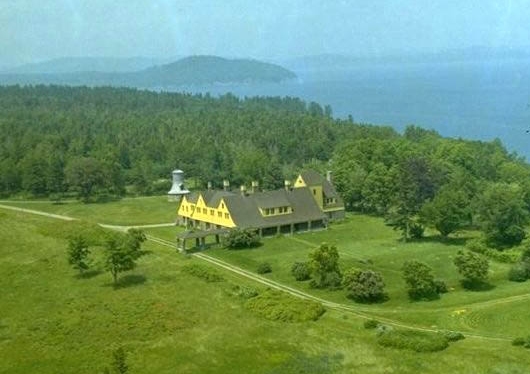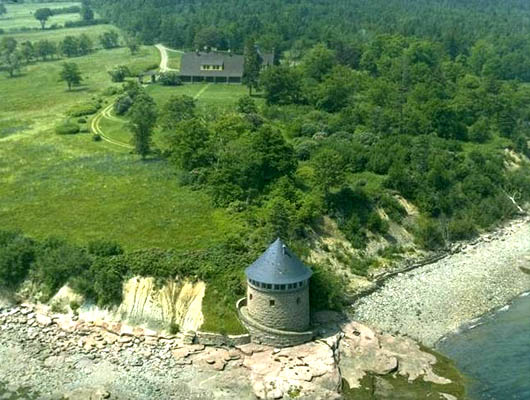
17 November 2007
Rail Baron's Retreat Gets Put Back on Track

Sir William Van Horne's Ministers Island, New Brunswick,
estate named "Covenhoven".
Ministers Island New Brunswick - After Sir William Van
Horne drove the last spike to complete the Canadian Pacific Railway in November of 1885, he must have worried that after overseeing the
completion of one of the greatest engineering feats of the 19th century his life might get boring. So, in 1892 he took on the eccentric
project of building an East Coast summer home, which involved something akin to the daily parting of the Red Sea.
The Van Horne mansion is near Saint Andrews, N.B., on Ministers Island in Passamaquoddy Bay, a body of water subject to tidal shifts of
up to seven metres. Every piece of material to build the railway magnate's sprawling estate - including a tanker car buried underground
to store fresh water - had to be hauled by horse-drawn wagons across the ocean floor during low tide. Even today, visitors
driving cars have to wait for the Bay of Fundy tide to ebb before crossing a kilometre-long sand road that connects Saint
Andrews and the island.
Van Horne called his 50-room summer mansion Covenhoven and when it was finished it was perhaps the region's most elaborate
home. But after the railway tycoon's death in 1915, the main house and outbuildings began decades of decline as ownership changed
hands. New Brunswick designated the estate a Provincial Historic Site in 1977 and bought the island in 1982 to prevent plans to
subdivide the property. But the province did not have enough money to maintain the glorious compound.
Today, 122 years after the famous last spike completed the rail line that sewed Canada together, area residents are hoping to turn
Covenhoven into a major tourist attraction, similar to the Roosevelt estate on nearby Campobello Island, which sees 70,000 visitors a
year. The group of citizens, who call themselves the Van Horne Estate on Ministers Island Inc., have operated the home for the past
four years, raising funds to restore the estate's gardens and rebuilding the property's windmill. This year, they boosted attendance by
30 percent by starting a boat service to the island, meaning that visits were no longer restricted to low tide.
Art MacKay, chairman of VHEMI, said the group is in the process of negotiating a long-term lease of the island and mansion
from the provincial government, giving it a legal right to manage the enterprise and apply to the Atlantic Canada Opportunities Agency
for a grant.
He said the group aims to raise $20-million for the estate's restoration and upkeep, some of which would hopefully come
from the federal government even though the man who knitted Canada together with steel rails was an American.
Van Horne, who was born in Joliet, Illinois, began his career at the age of 14, punching a telegraph key. He rose to become one of the
great railway barons of his time. If the moments of our lives are embedded in material things, the Van Horne mansion speaks of his
vanity, power, and personality. Its front, a kind of rural New Brunswick Parthenon, is marked by an outdoor portico with nine giant
stone pillars. That leads into a cavernous grand hall, empty now except for oil paintings on some of the walls done by Van Horne
himself.
The mansion has 50 rooms, of which the two largest were occupied by Van Horne and his wife, a fact pointed to by a docent in September
as the reason "they stayed so happily married for so long."
Van Horne summered here with his extended family: his wife, his daughter, Adie, who never married, his son, and his grandson,
Billy, who was his chief joy. Van Horne painted a mural on the boy's bedroom and signed it "Master Cornelius William Van Horne for
Billy on his 3rd birthday 1910."
But don't get the idea that Van Horne was an old softie. When he learned that the workers in his barn were spending too much time
gazing out the windows at Passamaquoddy Bay, he filled all the windows and placed new ones 10 feet higher, where they remain today.
Most rooms are empty. Their original contents have been sold by private owners over the years. Two pieces, which were too large to
move, remain: an imported English billiards table, measuring 12 by 6 feet and weighing 3,000 pounds, and an
11-foot-high, ornately decorated chest with the year 1642 carved into its wood.
In its heyday, the estate was a major farming and cattle operation with a heated greenhouse and an enormous barn. Dusty ribbons once
won at livestock shows still hang in the barn. Every morning when Van Horne was not in residence, fresh produce, including butter and
milk, was put in his private rail car waiting on a spur in Saint Andrews and rushed to Montreal in time to be on his dinner table.
For more information, call (506) 529-5081 or visit
ministersisland.org.

Sir William Van Horne's circular bathhouse on Minister's
Island, New Brunswick.
|